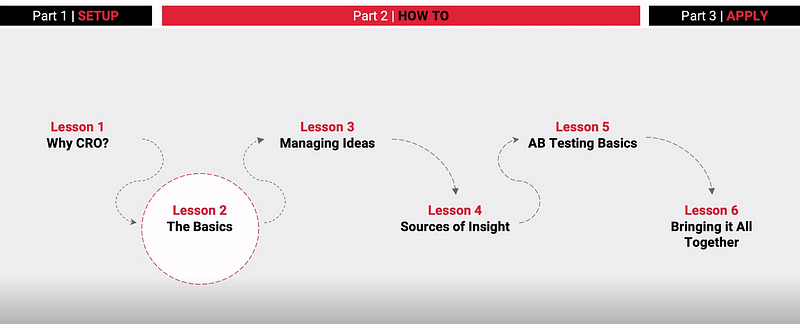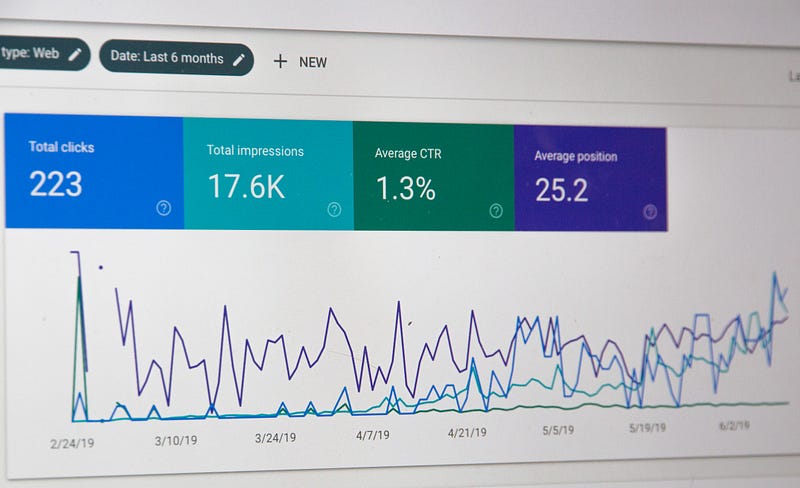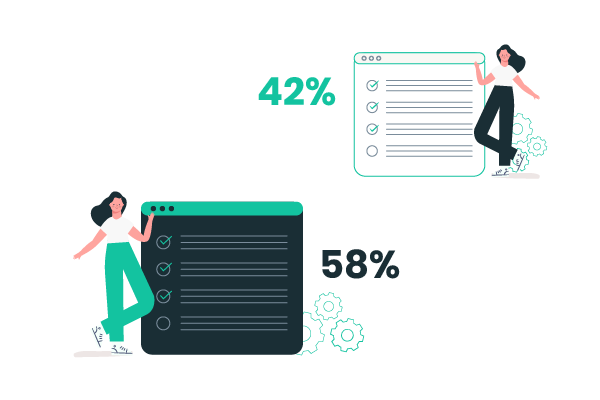-
Pingback: Best Practices For Conversion Rate Optimization - Part 1 - Jibran Yousuf Khan

Introduction To Conversion Rate Optimization
If we analyze the paradigm shifts of the Internet, we come across three paradigms in the past three decades, starting from the 1990s, with Yahoo & Lycos, to Google in the 2000s, followed by Social Media sites in 2010s.

And now the Internet is easily accessible by almost everyone, even in remote locations, which intrigued the businesses to grow their digital presence. And now every industry, including eCommerce stores, SaaS businesses, non-profit organizations, or even political campaigns, focus on their online presence. Now they all own a website, has their location on Google Map, takes online orders & sell their services, and influence the people around the globe right from their comfort of home.
Analysis of customer behaviour shows that between 70–80% of people research a company online before visiting a small business or making a purchase with them. 97% of consumers go online to find a local store or local services.
These paradigm shifts not only introduced a new scope of work but also added several new growth & marketing strategies & tactics to be implemented online for the hypergrowth of startups, & established businesses.
In this article, we will discuss one of the essential processes in growth marketing, i.e. Conversion Rate Optimization or as we call it CRO.

Before we dive deeper into the CRO, I would like to mention that the following content is based upon the learnings that I did during the First Week of Conversion Optimization, my nano degree course at CXL Institute, led by Peep Laja & team.
This course’s lectures were conducted by Brian Massey, the Managing Partner at Conversion Sciences.
Introduction To Conversion Rate Optimization
When we talk about online marketing, there are two ways to increase your revenue. Either you start driving more traffic to your website to increase sales, or you improve the overall website effectiveness to increase the number of people who purchase something from you. Conversion Rate Optimization (CRO) focuses on the second way. Let’s get started.

Why CRO?
Let’s consider that you have a website, and you are not getting enough conversion, visitors are not purchasing your products, your services are not selling, and you are not getting enough leads to convert them.
There are two ways to tackle the current situation. Either design a new website landing page OR gather the data based on current visitors, & analyze it. Based on this analysis, update the chunks of website layout design. Which one sounds better? I am sure you would go for the latter. However, Fishline.com went for the first one, in November 2012, and updated the whole website layout.


This step, damaged Finish Line business with an estimation of 3 Million US Dollars with a few weeks. This is where CRO comes into play, enabling you to do test-driven updates to your website, minimizing the risk factor of crashing the business.
CRO primarily focuses on the following:
- Decrease the Cost per Acquisition (CAC)
- Increase the number of leads
- Get more sales
So If your business has fewer leads, high bounce rate with a high cost of acquisition, you must focus on CRO processes to grow your business exponentially without risking the current growth.
The Basics
When we talk about improving the Conversion Rate, try sharing this objective with the colleagues around you. You will be bombarded with ideas, from your team, your boss, or the ideas that you took as inspiration from your competitors.
And most of the time, these ideas make their way onto the live website, without a proper framework to validate all those ideas. This happens due to several reasons, sometimes due to the political will of your superiors, while sometimes due to your confirmation bias of the idea that you suggested.
How to avoid this problem? Most of the people would say, let’s learn how to manage these ideas. No, the human brain has the built-in ability to distinguish ideas. We use this ability in our daily lives. Now, remember how many times you analyzed the current situation and curated a perfect status update or tweet for your social media profile, that brought a lot of engagement?
The last time you bought a product from Amazon, you got stuck between two variants, and you quickly went into reviews to decide which one to buy? All of these are the example that the CRO mindset is already wired into our brain; we just need to use in our business.

The above examples are also the daily life example of A/B testing. As you compare two updates, analyze the data, and choose the one that benefits you at most.
Now that you have an idea of what CRO is, we will talk about the three founding pillars:
- Managing the ideas
- Increasing the sample size
- Improving the quality of the sample.
Managing Ideas

Ideas are the oxygen for a digital marketer, that is large in number. As I said before, share the objective with your team, and you will be quickly having 10–20 ideas within an hour. Our brain is programmed to have multiple ideas. So how to decide which one is worth trying? And how to politely decline the idea of your boss or any senior authority in the business?
Simply, create a spreadsheet, and write down all the ideas in that list, gather it from the team & even from your boss.
Writing A Hypothesis
Now, write a hypothesis for every idea, in the given format.

Taking an example of Nonfig, I had the idea to change the text on the CTA button in your lead opt-in form on your main landing page, so I wrote the hypothesis for that.
If I update the CTA button text of opt-in form to Claim Your Free 3 Months
I expect to get more leads.
As measured by Number of leads in Google Analytics


Ranking Ideas
Once you are done with the hypothesis, rank your ideas based upon these three factors, usually rating them from 1 to 5.
- Impact — the effect of the idea post-implementation
- Confidence or Proof — the probability of achieving the desired impact
- Effort to Test — the amount of work required to conduct this test
Updating the CTA button text can create a significant impact, has the credibility to succeed based on the Copytesting rules, and the effort to test this change is minimal. Whereas changing the graphical assets used on the landing page from photos to vector might create a huge impact too. But the effort to test is high, and therefore we know the first test can be easily prioritized.
Sources Of Insight
Whenever we talk about initiating a test, it’s recommended to analyze the ideas based upon a number of data sources.
First of all, Google it. In this continually changing world, a number of marketers are regularly running tests and putting their findings on the web. Go through them, and check if your ideas are even testable or not.
Find out what is required to execute these ideas, maybe some just need a simple fix, whereas some need an update in layout design.

One of the most recommended sources of data is your website analytics, and it has everything that you are looking for before running a test. Analytics can help you save hours of work, and you will be able to understand the visitor behaviour more accurately analyzing the patterns.
Apart from the above, many tools give you insights and save you from the disappointment of running a test that shouldn’t be run in the first place. A few of these tools are:
- Hotjar — provides feedback through tools such as heatmaps, session recordings, and surveys.
- SessionCam — provides a click heatmap, a scroll map, and a screen recording feature to view how users behave on pages.
- Tobii — focuses on sensor technology that makes it possible for a computer or other device to know where a person is looking.
A/B Testing Basics

Whenever a person listens to the term Conversion Rate Optimization, their mind instantly thinks of A/B Testing. However, CRO is much more than just A/B Testing.
A/B Testing is the best way to collect visitors’ behavioural data by presenting them with different versions of a creative, or layout, or even a copy on your website.
When we talk about getting feedback about a particular feature, or an update, we consult it with our team, our friends, & the family circle. Most of the time, the feedback is not accurate, and they act as pretenders & liars.
A/B testing allows you to run the test, with both ends. As they both ends do not know the actual person behind the insight that you receive. CRO specialists will only get the numbers in forms of analytics. Whereas the visitor won’t even know that they are being tested, so their response is natural.
The key to running A/B Testing is to understand which tests need to be run. This is vitally important to avoid running tests where they are not required. Also, keep in mind that it’s not necessary that the test variant that you are supporting only because of your own confirmation bias will lead the test.
Bring It All Together – Conversion Rate Optimization
Conversion Rate Optimization is one of the fundamental processes of Growth Marketing. We learned what CRO is & why is it important. We also shed light on how great ideas are lost, while ideas supported by political will make it to the top. However, we came across the framework to manage ideas. Insights are essential. Once you have the list of sources of raw data, combined with the powerful features of excellent tools, it becomes the perfect recipe to run A/B Tests.
In the next article, I have discussed the Best Practices for the CRO.
Do you have any questions? Feel free to ask in the comments section below.